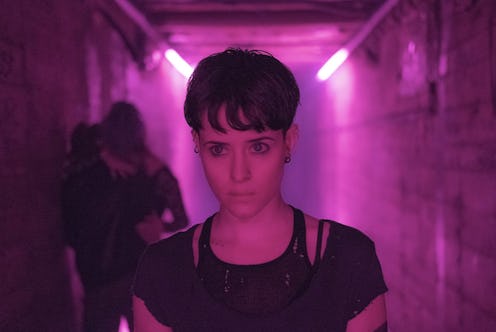Entertainment
These Are The Real Women Who Reportedly Inspired Lisbeth Salander

Hacker heroine Lisbeth Salander returns on Nov. 9 in The Girl in the Spider’s Web, the second American installment of the Millennium franchise. Though Steig Larsson passed away in 2004, the book series continued on past the three novels he'd written. And while the new film is based on a book by David Lagercrantz, it captures the essence of the original story. Lisbeth has been portrayed by three different actors (Claire Foy, Rooney Mara, and Noomi Rapace) throughout the years, with each bringing their own spin to who she is. But is Lisbeth Salander based on a real person?
Turns out, Lisbeth might have been loosely based on more than one person. The main rumored inspiration for the vigilante hacker is Therese Larsson, the author’s niece. The Daily Mail reported that her father, who is Larsson’s brother, confirmed Therese is the heroine behind her uncle’s popular novels. “My daughter Therese was the inspiration for Lisbeth Salander. That has already been established by both Stieg and us,” said Joakim Larsson to the Daily Mail.
Per the publication, Therese became estranged from her family after entering a relationship with a drug addict, who then died of an apparent suicide. But even as her relationship with the rest of her family was rocky, she found solace in her uncle.
Rolling Stone reported that when trying to explain his heroine to his brother, Larsson said, “She’s like Therese.” Larsson’s niece corresponded with him regularly during his time writing the novels. He would ask her about her life, and then seemed to interweave aspects of his niece's personality into Lisbeth. Therese told him about her passion for kickboxing and previously studying jiujitsu, as well as opening up about her struggles with anorexia.
Therese’s physical traits as a teen were very similar to Lisbeth’s: dyed jet-black hair, tattoos, black makeup, black leather jacket, and black boots. In her interview with Rolling Stone, she confirmed that her uncle had told her Lisbeth was inspired by her. “Lisbeth Salander is like you. Soft on the outside, but harder inside,” said her late uncle, according to Therese.
The other rumored inspiration for the character is far less lighthearted, showing a darker side of the story’s alleged origins. In an interview with ABC News, Larsson’s childhood friend Kurdo Baksi claimed that Larsson witnessed a 16-year-old girl being gang raped by his friends.
He reportedly failed to intervene, asking the girl for forgiveness days later. She did not accept his apology, but Larsson was riddled with guilt years later, writing Lisbeth as an empowering rape survivor who takes down abusive men. “It was his way of apologizing," said Kurdo. “Stieg told me, 'I need to write this book. 'It's really important to me. I saw a rape and I didn't do anything. I felt terrible about what I had seen.'”
Larsson created a heroine who takes her painful experiences and uses them as fuel to help others in similar positions. It’s clear that even with his alleged missteps, Larsson was dedicated to making women like Lisbeth feel like they’re not alone, and identify with a heroine that doesn’t fit the traditional mold of an action flick protagonist.